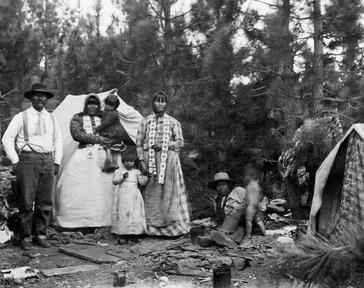|
9/24/2020 0 Comments The Washoe Way of Life Photo Credit: UNR Photo Credit: UNR The Washoe people are a Native American tribe who live in and around the Sierra Nevada range. Prior to European-American settlement, the Washoe ranged over the entire Tahoe area, following seasonal variation in food, following acorn abundance well into the foothills of the Sierras to the west, fishing and bird migrations as far south as Mono Lake and North beyond Honey Lake, and retreated east into the Pine Nut mountains and Great Basin region for the colder winter months. Nevada and California became US territories following the Mexican-American war in 1848, and almost immediately, the discovery of gold and silver in both territories resulted in a surge of immigrants settling within the Greater Tahoe area. Along with settlement, came industry, which had lasting effects to the Washoe way of life who depended on the availability of specific food sources throughout the year. Overexploitation of fishing grounds, excessive logging of old-growth forests, and the introduction of land ownership eventually forced the tribe to adapt and assimilate into the new lifestyle imposed by the incoming settlers. Today, the Washoe tribe remains an active population of citizens who carry and protect Washoe tradition. We encourage you to explore their website https://washoetribe.us/ to learn more about their history and culture. It is important for us all to remember that these lands were once inhabited by people who did not see themselves as separate from the land. We can all learn something from the Washoe way of life, as we confront the same issues of environmental degradation that were introduced to this area just over 150 years ago. “The health of the land and the health of the people are tied together, and what happens to the land also happens to the people. When the land suffers so too are the people. - A. Brian Wallace, Former Chairman of the Washoe Tribe
0 Comments
9/17/2020 1 Comment Ecology of Kokanee Salmon Spawning Kokanee Salmon, note the difference between females and males. Photo by Hemming1952 via Wikipedia Spawning Kokanee Salmon, note the difference between females and males. Photo by Hemming1952 via Wikipedia Kokanee salmon are landlocked sockeye/red salmon. This means they never travel to the ocean from the stream they were born in; instead, they go to lakes to live their adult years. Kokanee salmon start out as eggs laid by females in a stream gravel nest called a redd, then hatch into alevin and continue to feed on their egg sacs, staying in the gravel nest. After this stage they grow into fry that continue to live in the gravel for about one month and start to feed on zooplankton, the primary food source of Kokanee. The Kokanee then enter the juvenile stage, the transition between fry and adult. At this point they begin making their way in schools from the stream they were born in to the lake where they spend their adult lives. If they live to be an adult Kokanee salmon, they spend a few years as a non-mating adult. Chinook salmon, eagles, and humans are the primary predators of Kokanee salmon. They also may be killed off due to competition for habitat, change in water temperature, sedimentation, and changes in oxygen in the water. When they are about 4-5 years it is time to spawn. They change color to a red body with a gray-green head. The male has a hump with a hooked mouth while the female stays relatively in the same shape as pre-mating. Adults return to the same stream that they hatched to spawn, lay eggs, and die. The cycle is then repeated by the surviving offspring. 9/2/2020 1 Comment Salamanders Mount Lyell Salamander, endemic to the Sierra Nevadas. PC: Amy, via Encyclopedia of Life Mount Lyell Salamander, endemic to the Sierra Nevadas. PC: Amy, via Encyclopedia of Life Salamanders are very unique creatures. They’re amphibians, so they spend their life moving between water and land, always staying close to a water source. While they look like lizards, with a long body and tail and two pairs of legs coming off the sides of their body, they have no scales, and are smooth and moist to the touch. Most salamanders are opportunistic predators, and will feed on anything that’s about the right size for them. Because of their life strategies, salamanders live near water and can’t travel very far from a water source, making it difficult for a population to move to better habitat. For salamanders native to the dry regions of the American west and southwest, this can be harder than it sounds. Many salamander species in these regions are threatened or endangered due to several factors pertaining to their habitats. Habitat degradation, through logging, overgrazing, and the draining of wetlands can devastate a population of salamanders by disrupting the creeks, plants, and animals of their home. Populations are often separated by roads, which can be a source of mortality when salamanders try to cross these roads and are struck by cars. Salamanders are also injured or killed when water sources are modified, either physically or chemically. The construction of dams, introduction of pollution, human recreation, and creation of canals can all hurt a salamander population and kill individuals. So what can we do to protect these animals? Here are three easy things we can all do to help salamanders:
|
AuthorThis blog is managed by the staff and volunteers of Galena Creek Visitor Center. We write about parts of the natural world that we find fascinating and want to teach others about, as well as keeping you updated on the Visitor Center and park. If you want to learn more, please sign up for our monthly newsletter, where we share upcoming events, updates on the ecology of the park, and highlights from each month. Archives
October 2021
Categories |
 RSS Feed
RSS Feed
